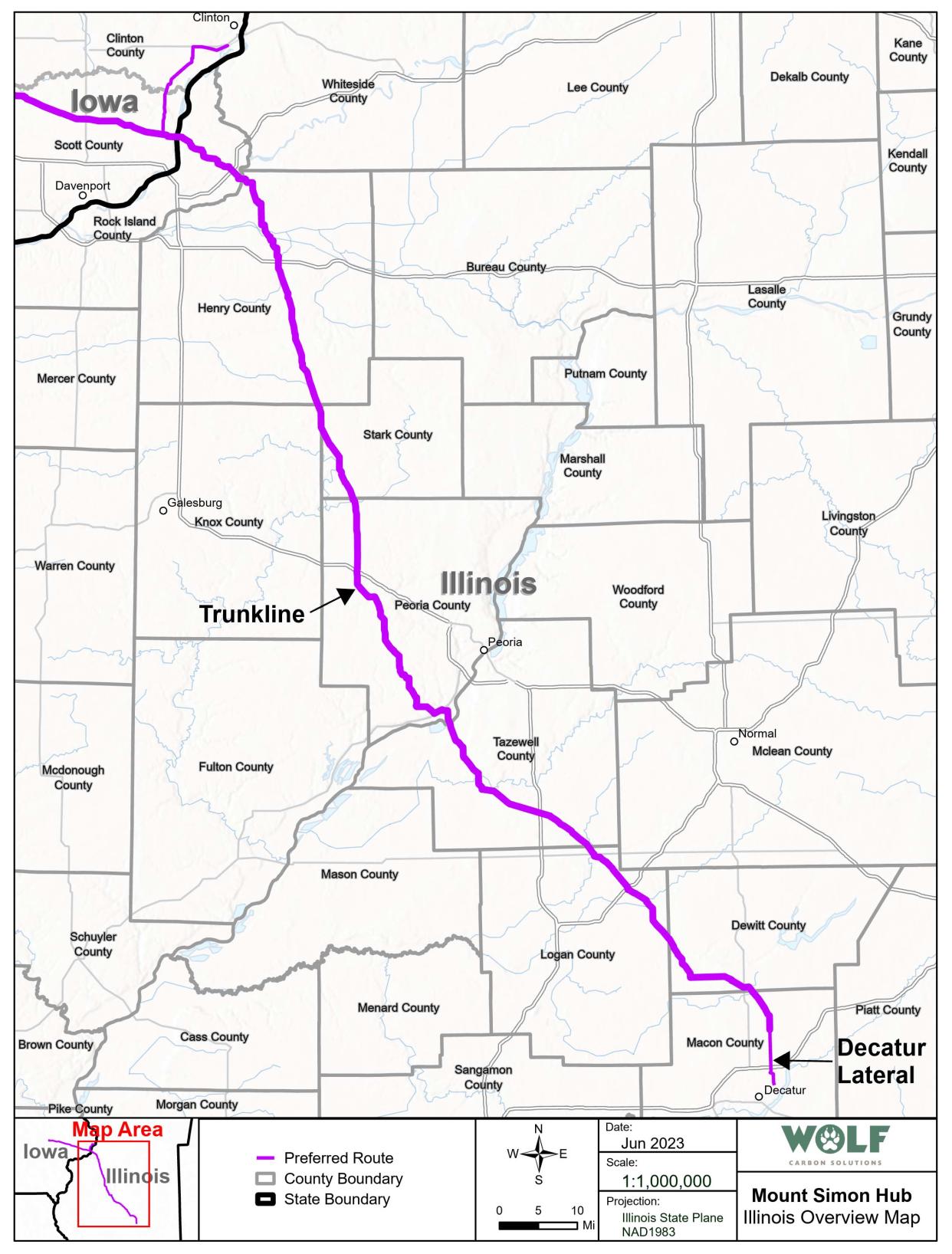Protests mounting over proposed CO2 pipelines cutting across Peoria, Tazewell counties

PEORIA — As legislation dictating safety measures for CO2 pipelines languishes in the Illinois legislature, two corporations are pushing forward with plans to lay hundreds of miles of pipe through central Illinois.
Navigator Heartland Greenway LLC filed an application with the Illinois Commerce Commission on Feb. 24 for 292 miles of pipeline which includes a section ending in Marshall County near Henry. On June 16, Wolf Carbon Solutions U.S. filed an application for a pipeline that would run through Stark County and bisect both Peoria and Tazewell Counties.
According to information in Wolf’s ICC application, 166 miles of pipeline will cross Illinois and transport up to 12 million metric tons of CO2 collected from two ethanol producing ADM plants in Iowa. The pipeline would begin in Cedar Rapids and cross Illinois in a diagonal run, ending at the ADM facility near Decatur which utilizes the Mt. Simon aquifer for underground CO2 storage. The natural geologic formation is believed to be capable of containing between 12 to 172 billion metric tons of CO2.
Related: What to know about Navigator's new, expanded C02 pipeline application
As of now, the pipeline proposed by Wolf Carbon Solutions is not coming through the city of Peoria, but that could change if BioUrja, the ethanol plant in Peoria, decides to hook on to the pipeline.
“We continue to talk to ethanol facilities all along our trunkline, and BioUrja is someone that we’re talking to,” said Nick Noppinger, Senior Vice President of Corporate Development at Wolf Carbon Solutions.
If that happens, a spur off the main pipeline will run through Peoria’s well-populated south side.
Concerned about safety
While the building of pipelines is often controversial, there’s an added twist to the building of CO2 pipelines because they are being proposed as a way to fight climate change.
CO2 produced by various manufacturing processes would be diverted from the atmosphere, where it is contributing to global warming, and injected into underground storage facilities. Proponents say the pipelines would have a positive effect on the environment and help the U.S. to achieve net zero emissions by 2050.
This theory has gained traction among politicians from both parties and resulted in the creation of massive federal incentives for those willing to build the infrastructure. In May, the Biden administration announced $251 million to support 12 projects across seven states to bolster the nation’s carbon management capabilities.
But many people question the benefits and worry about safety. In Iowa, pipelines have been met with resistance, and activists in Illinois have also begun to join the fray.
“I’ve been using the term “wild, wild west” for these investors who think they can make hundreds of millions of dollars while we continue to produce carbon dioxide and burn fossil fuels so they can burn their coal, they can burn the oil, they can burn the gas forever,” said Peoria resident Joyce Harant, a longtime environmental activist and a trustee with the Peoria Park District, which passed a moratorium on the pipeline during their meeting in June.
Though no Peoria Park District land is along the route of the proposed pipeline, trustees wanted to make a statement about the project, which they see as a possible threat to the community.
“Any explosion would reasonably impact users of our park or staff, and our facilities," said Harant.
Opponents of the pipeline point to a 2020 pipeline explosion in Satartia, Mississippi, which forced the evacuation of more than 200 people and sent at least 45 people to the hospital. Accounts from that incident detail how people passed out when the cloud of CO2 descended, and emergency responders were unable to help because vehicles could not run due to lack of oxygen.
Furthering these concerns is a perceived lack of state and federal oversight of CO2 pipelines.
“We were hoping this last spring to pass legislation that would have provided comprehensive regulation for this —the sequestration piece and the pipeline piece — because right now there’s really very little to protect people in the state of Illinois,” said Harant.
Proposed legislation

Legislation introduced during the now concluded Illinois General Assembly spring session could address some of those concerns. The Carbon Dioxide Transport and Storage Protections Act, listed under Senate Bill 2421 and House Bill 3119, did not advance out of their respective chambers but could be moved during veto session in late October.
Bill sponsor Rep. Ann Williams, D-Chicago, said work to strike the right balance between a burgeoning industry and needed environmental safeguards in ongoing.
“We are dealing with something that we've not seen to this scale that's being proposed here in Illinois, so we want to make sure we get it right,” she said. Her bill has garnered bipartisan sponsors.
Messages left for Peoria-area lawmakers, GOP Rep. Ryan Spain and Democrats Sen. David Koehler and Rep. Jehan Gordon-Booth, requesting their view on the legislation were not returned.
Environmental groups announced their backing of the legislation during a May rally held at the Illinois State Capitol. The Sierra Club Illinois supports the bill’s determined setbacks of how far a pipeline must be from a property and placing the liability for any damages on the company instead of the taxpayer.
The bill addresses the need for specialized training for emergency responders, a response to findings in a report by the U.S. Department of Transportation and U.S. Pipeline and Hazardous Materials Safety Administration following the pipeline explosion in Satartia.
Denbury Gulf Coast Pipelines, LLC — the company operating the pipeline — had not participated in an emergency drill with first responders or had provided the proper notice to first responders. Williams’ bill would require companies to pay for the "training for carbon dioxide emergencies for emergency responders, medical personnel, residents, businesses, and other local entities," which she said is only part of a needed partnership between operators and local communities.
The bill also addresses ownership of pore spaces, the subsurface area where the liquified carbon dioxide would be stored. It would not be granted to operators but instead belong to the owner of the surface area. This has been a primary concern for the agriculture community, which has largely opposed eminent domain claims by companies wishing to construct pipelines.
A three-year track record of safety
Noppinger, Wolf’s VP of corporate development, pointed to the corporation’s track record when asked about safety measures on their proposed Illinois pipeline.
“We have a dense phase carbon system up in Canada called the Alberta Carbon Trunk Line, ACTL for short. It’s the only dense phase CO2 system in north America, and we’ve been safely operating it for over three years. We will apply those rigorous development and operational techniques down to the U.S. to ensure a safe pipeline,” he said.
Pipeline shut-offs will be placed according to population and environmental factors, no more than 7.5 miles apart in high consequence areas, and 20 miles apart in non-high consequence areas. The company has also created a detailed emergency response for communities near the pipeline.
“We have an emergency response plan that is incredibly robust,” said Noppinger. “We’ve been taking that binder, and showing that to local stake holders and first responders to communities across the trunk line, and it’s been a very helpful tool in educating them and getting them comfortable with the safety and security of CO2 pipelines.”
Wolf’s emergency response plan includes continuous training and testing for first responders, with both tabletop exercises and live drills; a clearly defined site incident command structure; and detailed plans for both internal and external communications.
Project timeline
Wolf began contacting landowners along the proposed pipeline route after filing their application with the ICC in June. Noppinger said the company did not use eminent domain to acquire easements for their Canadian pipeline, and they do not plan do use it in Illinois.
The pipeline will run on a 200-foot-wide easement and be buried deep enough to not interfere with farming operations.
Pending regulatory approvals, Wolf Carbon Solutions expects to begin construction of the pipeline in the second quarter of 2025 and operations later that year.
Reporter Patrick Keck of The State Journal-Register contributed to this report.
Leslie Renken can be reached at (309) 370-5087 or lrenken@pjstar.com. Follow her on Facebook.com/leslie.renken.
This article originally appeared on State Journal-Register: Proposed CO2 pipelines could cut through central Illinois by 2025

